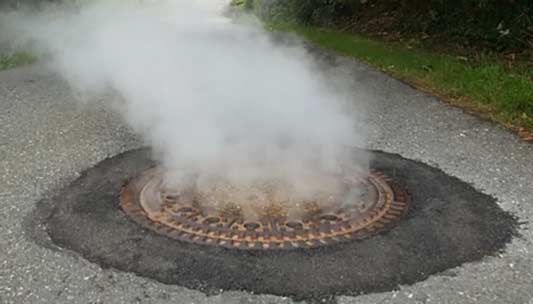The Importance of Smoke Testing for Sewer Odors
In a residential or commercial property, sewer odors can be a significant issue. Not only are they unpleasant, but they can also indicate underlying problems with the plumbing system. Identifying the source of sewer odors can be challenging, as they can originate from various points within the system. However, one effective method to pinpoint these sources is by using a smoke test. This article will guide you through the process of using a smoke test to find and eliminate sewer odors.
What is a Smoke Test?
A smoke test is a technique used to detect leaks, cracks, or other defects in a plumbing system that can cause sewer odors. It involves introducing a non-toxic, odorless smoke into the pipes, which then travels through the system and exits wherever there is a defect. The smoke is typically generated by a smoke machine and is harmless to humans, pets, and the environment. By visually identifying the areas where smoke emerges, you can pinpoint the sources of sewer odors and take appropriate measures to fix them.
The Benefits of Using Smoke Testing
Smoke testing offers several advantages when it comes to detecting sewer odors:
- Efficiency: The smoke used in these tests is highly visible, making it easy to spot even minor leaks or cracks in the plumbing system.
- Cost-Effectiveness: Smoke testing is a relatively affordable method compared to other diagnostic techniques, such as intrusive inspections or extensive excavations.
- Non-Destructive: Since smoke testing doesn’t require any invasive procedures, it minimizes the risk of damage to the property during the detection process.
- Precision: By identifying the exact locations where smoke emerges, you can prioritize repairs and eliminate sewer odors more effectively.
Preparing for the Smoke Test
Prior to conducting a smoke test, there are a few essential preparations that need to be made:
- Notify Residents or Occupants: Inform all residents or occupants in the building about the upcoming smoke test. It is important to ensure that everyone is aware of the test to prevent unnecessary panic or confusion.
- Turn Off Smoke Detectors: As a precautionary measure, it is crucial to disable any smoke detectors temporarily, as the smoke used in the test may trigger them.
- Seal Drains: Seal off all drains in the building, including sinks, bathtubs, and floor drains. This prevents the smoke from escaping through the drains and allows it to travel through the plumbing system.
Conducting the Smoke Test
Once the necessary preparations have been made, you can proceed with the smoke test. Here is a step-by-step guide:
Step 1: Create the Smoke: Using a smoke machine, generate the non-toxic smoke that will be introduced into the plumbing system. Ensure that the machine is functioning correctly and producing sufficient smoke.
Step 2: Introduce the Smoke: Locate the cleanout access point in the plumbing system, which is typically found near the main sewer line. Remove the cleanout cap and insert the smoke machine nozzle, ensuring a secure fit.
Step 3: Observe the Smoke: As the smoke is introduced into the plumbing system, carefully observe the areas where smoke emerges. Pay attention to any signs of smoke near fixtures, drains, or other potential problem areas.
Step 4: Document the Findings: Keep a record of the locations where smoke is observed. This documentation will be useful for further analysis and for developing a plan to address the issues causing sewer odors.
Step 5: Professional Evaluation: If you are unsure about the severity of the issues or if complex repairs are required, it is advisable to contact a professional plumber or sewer smoke testing specialist. They can help you interpret the findings and provide expert guidance on resolving the underlying problems.
Addressing the Detected Issues
Once the smoke test has identified the sources of sewer odors, it’s crucial to take prompt action to address the issues. Depending on the severity of the problems, the required actions may vary:
If the issues are minor, such as a cracked seal or loose connection, you may be able to fix them yourself. Ensure that you have the necessary tools and materials to complete the repairs.
For more complicated issues, such as damaged pipes or inadequate ventilation, it is recommended to hire a professional plumber. They have the expertise and specialized equipment to carry out the repairs safely and effectively.
Remember, resolving sewer odor problems promptly not only eliminates unpleasant smells but also helps maintain a healthy and comfortable environment within your property.
Preventive Measures to Avoid Sewer Odor Issues
While smoke testing is an excellent method for identifying existing sewer odor issues, it is always better to prevent these problems from occurring in the first place. Here are some preventive measures you can take:
- Regular Plumbing Inspections: Schedule periodic inspections by a professional plumber to detect any potential issues before they escalate. This can help address minor problems before they result in sewer odors.
- Proper Ventilation: Ensure that your plumbing system is adequately ventilated to prevent the accumulation of sewer gases. Professional plumbers can assess your ventilation system and make necessary adjustments.
- Regular Drain Cleaning: Establish a routine for regular drain cleaning to prevent clogs and the build-up of organic materials that can cause sewer odors.
To Sum It Up
Using a sewer smoke test to find and eliminate sewer odors is a practical and efficient method for property owners. By following the steps outlined in this article and seeking professional assistance when needed, you can maintain a clean and odor-free environment within your home or business. Remember, early detection and timely repairs are key to preventing further damage and maintaining a healthy plumbing system.


